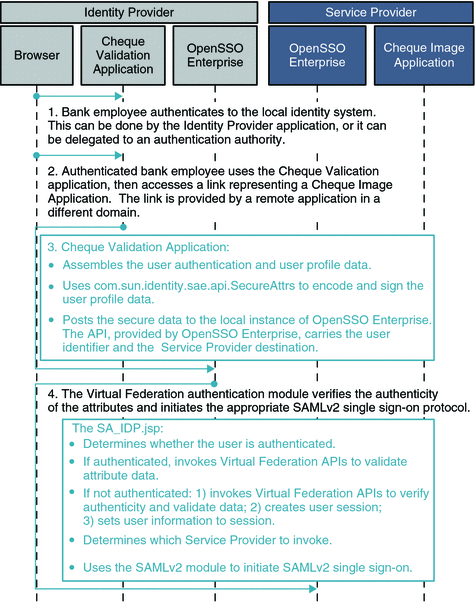Analyzing the Deployment
Secure Attributes Exchange uses the SAMLv2 protocol to transfer identity data between the communicating entities. The Secure Attributes Exchange client APIs, including both Java and .NET interfaces, run independently of the OpenSSO Enterprise instance. The Secure Attributes Exchange client APIs enable existing applications to handle the SAMLv2 interactions.
The following figure illustrates the deployment architecture for Secure Attributes Exchange.
Figure 6–3 Deployment Architecture for Secure Attributes Exchange

In this Secure Attributes Exchange example:
-
Secure Attributes Exchange acts as a pure SAMLv2 protocol gateway, relying entirely on the existing applications for user authentication and retrieval of the user profile attributes.
-
From the perspective of Identity Provider applications and Service Provider applications, Secure Attributes Exchange implements a push-model solution to securely transfer authentication and attributes data.
-
Secure Attributes Exchange uses simple HTTP GET/POST and data signing and encryption to securely transfer authentication and attributes data from and to legacy applications.
-
Secure Attributes Exchange supports both symmetric-key and asymmetric-key based cryptography to secure authentication and attributes data
-
Secure Attributes Exchange supports application-initiated single sign-on and single logout.
The figures Figure 6–4 and Figure 6–5 illustrate the process flow in a typical Secure Attributes Exchange interaction. In this example, bank employees each have a user account in a bank's employee identity system. Employees routinely access an internal application that validates bank customers' personal checks. The bank employees are required to authenticate themselves before accessing the Cheque Validation application. Validating checks involves retrieving the check images which are stored and processed by the Cheque Image application. The Cheque Image application which is hosted by a business partner at a remote site. User identity and attribute data must be supplied by the local Cheque Validation application and passed to the remote Cheque Image application in a secure manner.
Figure 6–4 Process Flow for Secure Attributes Exchange (Continued on next page)

Figure 6–5 Process Flow for Secure Attributes Exchange (Continued)

- © 2010, Oracle Corporation and/or its affiliates
